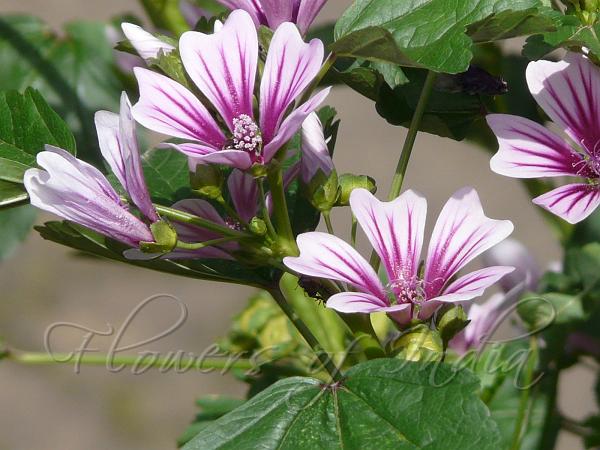|
| High Mallow |
|

|

| File size | 512212 |
| Original date | 6/6/10 10:36 AM |
| Resolution | 2560 x 1920 |
| Flash | Flash did not fire, auto |
| Focal length | 81.1mm |
| Exposure time | 1/500s |
| Aperture | 6.3 |
| Focus Distance | |
| Metering Mode | Multi-segment |
| Camera make | Panasonic |
| Camera model | DMC-FZ18 |
| Sensor type | OneChipColorArea |
|
|
|
|
Photo: |
Botanical name: Malva sylvestris Family: Malvaceae (Mallow family)
High Mallow is a spreading perennial herb, about 3 ft tall. In wild it can
grow taller. Stems are straight or prostrate, branched and covered with
fine soft hairs or none at all. The leaves are alternately arranged, deep
green, soft, and downy. They are roundish, and have 3-7 shallow lobes,
each 2-5 cm across. Leaf stalk is either 2-6 cm or 2-13 cm long. The
flowers are large, numerous, and of purple color. They appear in clusters
of 2-4 in leaf axils. Sepals are five, petals five, pollen large, whitish.
Petals are wrinkly to veined on the backs, more than 1.5-2.3 cm long and 1
cm wide, eggshaped, margin notched with a fringe of hairlike projections.
Seeds or 'cheeses' are brown to brownish green when ripe, about 2.5 mm
wide, 5-7 mm in diameter and are shaped like a cheese wheel which inspired
on of its common names. High Mallow is widespread in Africa, Europe and
Asia. Within India it is found in the Himalayas, from Kashmir to Kumaon up
to an altitude of 2400 m.
Medicinal uses: High Mallow possesses the properties common to
mucilaginous herbs, and an infusion thereof forms an excellent demulcent
in coughs, irritations of the air-passages, flux, affections of the kidney
and bladder, etc. In inflammatory conditions of the external parts, the
bruised herb forms an excellent application, making, as it does, a natural
emollient cataplasm.
High Mallow possesses the properties common to
mucilaginous herbs, and an infusion thereof forms an excellent demulcent
in coughs, irritations of the air-passages, flux, affections of the kidney
and bladder, etc. In inflammatory conditions of the external parts, the
bruised herb forms an excellent application, making, as it does, a natural
emollient cataplasm.
Medicinal uses:
 High Mallow possesses the properties common to
mucilaginous herbs, and an infusion thereof forms an excellent demulcent
in coughs, irritations of the air-passages, flux, affections of the kidney
and bladder, etc. In inflammatory conditions of the external parts, the
bruised herb forms an excellent application, making, as it does, a natural
emollient cataplasm.
High Mallow possesses the properties common to
mucilaginous herbs, and an infusion thereof forms an excellent demulcent
in coughs, irritations of the air-passages, flux, affections of the kidney
and bladder, etc. In inflammatory conditions of the external parts, the
bruised herb forms an excellent application, making, as it does, a natural
emollient cataplasm. | Identification credit: Gurcharan Singh | Photographed in Shillong, Meghalaya & Mandi, Himachal Pradesh. |
• Is this flower misidentified? If yes,